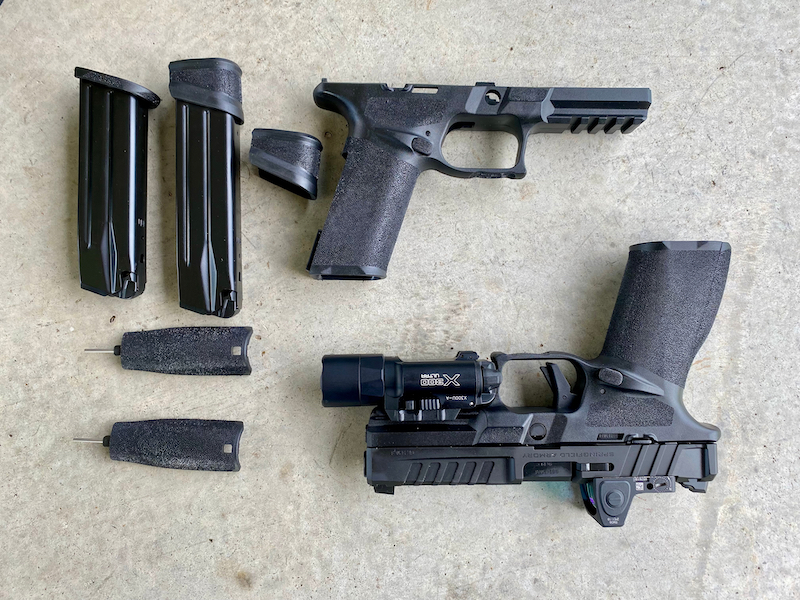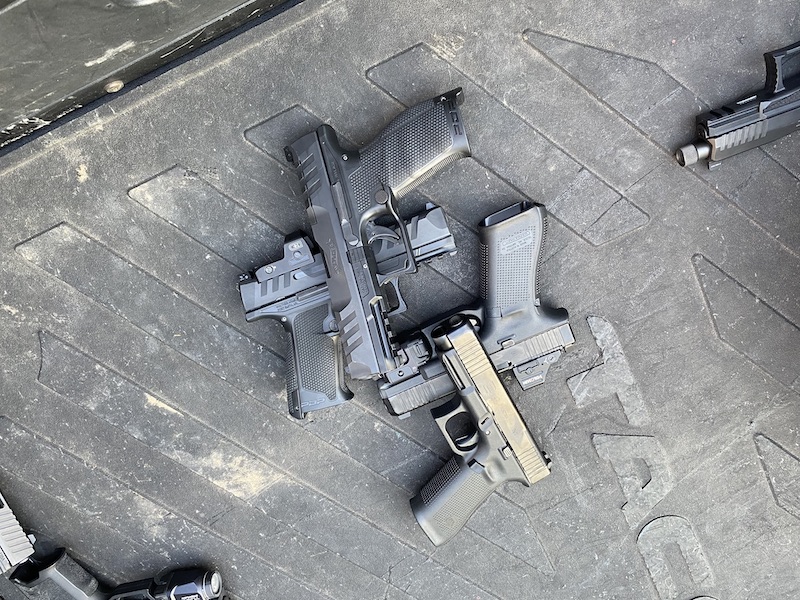For decades now, Glock has held its own against some epic competition when it comes to duty pistols. While Glock remains the undisputed industry leader, others have tried to hold their own or stake new claims. This includes Beretta, Smith & Wesson, and Sig Sayer. But despite winning contracts and loyal fans, the 92FS, M&P, and P365 haven’t really seized the popular imagination, much less market adoption.
However, for now, I want to keep my sights squarely on three designs: the Glock 45, the Walther PDP, and the Springfield Echelon. If I were in the market for a full-sized or compact 9mm—one that can function as well OWB as IWB—this is where I’d start.

Glock’s Dominance
Glock pistols work. They don’t fail. I’ve got a G19 with a high round count that I’ve yet to clean, and it performs like a Glock should. Lately, I’ve been carrying a Glock 45. The mix of compact length with the full-size mag capacity makes this a favorite for me. But I’ve recently picked up a G47, too, and I like the way it handles. Through all of this, I don’t want there to be even a hint that I don’t respect what Glock does and has done.
Glock’s success has been built on two solid concepts. The first, reliability, is undisputed. The second is more philosophical: all Glock pistols function and look exactly the same. Maybe there’s a third concept, actually, as no conversation about Glock is complete without praise of the magazine; they just work.
While other gun companies have caught up on the reliability side, all of the companies mentioned here have made dramatic changes to their controls, exteriors, and even the guts of the guns. When new models are released, they sometimes don’t look anything like the brand, historically. Glock has made small changes to the guns for performance updates and for ergonomic improvements, but those changes have been very subtle.
Here’s the rub. When these changes were new back in the 1980s, the G17 and G19 were revolutionary. Now, they may literally be symbolic of your grandfather’s gun. The plastic fantastic… the Tupperware gun… well, now, it is the establishment.
Unseating Glock
Here’s where we get a bit controversial. And, admittedly, what follows is based on conjecture. Some crystal ball gazing.
What is wrong with the Glock design? The gun, especially the G19, has long been a platform for personal expression. Just look at the depth of the aftermarket parts industry for Glock pistols.
In the years since Glock patents expired, all of the clones have hit the market with the simple premise that they can fix some of the ergonomics and controls and allow for more customization of the platform. Most of these, though, have a steep price and limited availability, and anyone who has any desire to take some of Glock’s market share needs to be able to produce at scale.
The Walther PDP
But what about other factory options for big brands? Walther’s Performance Duty Pistol (PDP) is a solid contender. The PDP is an evolution of the PPQ, a gun that should have had a much more dedicated following than it did. While Walther’s legacy still rests heavily on the old PPQ, their new polymer guns are gaining traction.
For me, the best part of the PDP is its trigger. Walther makes the best factory triggers available and has gone to great lengths to produce triggers that are consistent, clean, and have short take-ups and even shorter resets.


The trigger on these PDPs is exceptional, breaking just over five pounds. The take-up is just a quarter of an inch, and the reset is clean, easy to feel, and very short. As the recoil is easy to control, this combination of attributes with this trigger makes follow-up shots fast and reliably accurate.
As for that recoil control, I’d put the PDP squarely in the middle of the field here. The grip is very well contoured. I’ve got big hands, and the PDP fits perfectly without any of the boxy feeling that dominates some of its competition.
This makes drawing the PDP an intuitive experience. My hand hits the grip, rides high, and I never have to think about choking up on it or getting the right adjustment. The result is a clean draw that points intuitively toward the target. In dry-fire practice, I move from holstered to on-target in one smooth motion. By the time I have the gun high enough to begin looking for sight alignment, I am almost always close.


The depth of the PDP’s palm swell, too, helps keep recoil in check. It is missing the texture on the side of the frame, but it is easy enough to hold down. To date, I’ve not had a single failure in the PDP, not with the PDP magazines or with the gun.
The Echelon, by Springfield Armory
Springfield’s Echelon takes this notion of evolving ergonomics to the next logical level.
My favorite part of the Springfield Echelon is the direct optic mount. The Echelon has been designed to take just about all of the full-sized red dot mounts, and they don’t need adapter plates. As a writer who frequently has to mix and match parts for reviews, this is the best thing ever. I realize almost everyone else will pick an optic and stick with it, so adapter plates are hardly a deal breaker, but why not simply mount your optic directly to the slide?


The Echelon is the new kid on the block. While the PDP is new, too, it has a few years on the new Springfield and a more direct evolutionary line. Echelon, which still exists only in the full-sized model, is miles above the XD line (if only in that this feels like a much more refined design).
While the PDP is ergonomically superior to the Glock, the Echelon takes it even further. This gun’s index points have both contour and texture, making it the easiest of the three to control.
Back to the question: who could unseat Glock?
Let’s rephrase that. It isn’t who, but what. What development milestone will finally provide an edge over the 40-year track record that Glock has built?
Think back to Glock’s original G17. Glock didn’t invent polymer frames, but the G17 changed the entire market with its polymer frame.
I mentioned the P365 line earlier. The announcement of the P365 FUSE, which came out as I was working on this article, puts that micro-compact in the compact size. To date, Glock is falling behind with the G48 line (if only in terms of capacity). So, this may be the first crack in the foundation.


But let’s stick with a more apples-to-apples comparison. Full-sized duty pistols and/or compacts.
Controls: I’ve pointed to a couple of features here. Ergonomics are key. The PDP feels so much better in the hand than the typical double-stack 9mm Glock grip. And, the wings on the sides of the Echelon provide a dynamic control surface that is fast becoming the norm for these guns.
Customization: Glock keeps putting out odd hybrid models, but there’s little of the mix-and-match that you can do yourself like you can with chassis guns. The PDP boasts that any of the frames can be combined with any of the slides. While there’s still only one size of the Echelon, there are different grip modules. For now, if you know the one size you want, this remains a toss-up. Still, Glock isn’t embracing the chassis.
Ease of use: If everything else is created equal (like the price, availability, and reliability), fast always wins. How easy is it to mount an optic? How fast can you get on target from the holster? Is it easy to reload? This is determined by a bit of personal preference. Check them out and see which feels right. I’m faster with a PDP than I am with a G17, and faster with an Echelon than I am with a PDP.


Which would I choose?
If it all kicks off tomorrow, my Glock 45 will be at my side. I bought my first Glock more than a decade ago and have a long track record with it. I know it inside and out. Longevity and unfailing magazine design remain important considerations for me, too. But I’m tired of fighting the optics mounting plate, and I’m growing very fond of the thumb-ledge wing designs. If I ever shelve my Glock, one or both of those will be the reason (most likely the continual frustration I have from mounting optics).
If you have smaller hands or have difficulty working slide-stop levers, there’s no beating the PDP. Walther’s made an adaptable gun that racks easily and that needs no modification. And the sights on these, for those who shoot with irons, are also capable of finely tuned accuracy.
The real underdog here is Echelon. I’ve had this gun for almost a year, and it is by far my favorite gun to shoot of these three. After years of shooting 1911s and Glocks, I find that the Echelon makes everything easier. It is ridiculously fast and easy on the hands. As soon as the aftermarket options begin to catch up, and, maybe even more significantly, Springfield fleshes out the Echelon line with other sizes that are more practical for concealed carry, this could be the dark horse that unseats the incumbent.
Read the full article here


![Best 10mm 1911 Pistols [Field Tested] Best 10mm 1911 Pistols [Field Tested]](https://gundayfunday.com/wp-content/uploads/2024/12/10mm-1911-feature-colt-delta-elite-390x220.jpg)


![G9 Defense New 9mm 126-Grain Copper Subsonic Ammunition [FIRST LOOK] G9 Defense New 9mm 126-Grain Copper Subsonic Ammunition [FIRST LOOK]](https://gundayfunday.com/wp-content/uploads/2024/12/9mm-Sub3-390x220.png)